Vietnam's Coffee and Pepper Potential Through the Eyes of a Farmer
Dung Vo Ngoc shares insights on pepper, coffee and breakfast banh mi
Hello everyone!
We had a mini party with last weekend’s paid subscriber Selfie Shouts. Folks shared their cooking and craft project tips, posted career milestones, and celebrated life, family, and love. Your endeavors are awe inspiring. The winner of the Selfie Shouts drawing were Elise and Jan. Thanks to all who took part.
Now about the Vietnamese farmer . . .
You may use estate grown, traceable, single source, fair trade products from all over the globe but how often do you get to meet the people that produce them? This past summer in Vietnam, I met the person who grows my favorite peppercorns.
The motherland exports a lot of coffee and pepper but most of it is packaged and sold without information about where it comes from. For many years, I’ve been purchasing Burlap and Barrel’s peppercorns that they clearly mark as sourced from Dak Lak, a province that pretty much defines Vietnam’s mountainous central highlands, which is synonymous with coffee cultivation. The area is under-the-radar and worth checking out, as I wrote here.
While planning our trip, I emailed Burlap and Barrel co-founder Ethan Frische about Dak Lak. He connected me with someone on the ground: Dũng Võ Ngọc, the farmer of the aforementioned peppercorns.
Dũng’s response: Come to visit my farm. I will host you and make you a cup of coffee.
I’ve hung out with and reported on farmers in the States but never in Vietnam. I enjoy Dũng’s pepper daily. He grows coffee too? Heck, yeah!
Dũng had arranged for us to be picked up at the airport by a local ride share system generically called xe đò — but it wasn’t like a car and driver were waiting with an “Andrea Nguyen” sign. We trusted his judgement and squeezed into a packed van for the journey to Krong Nang to meet Dũng and his wife Hạnh. (He reserved front row VIP seats so we could take in all the views!)
Xe đò (“seh daw”) is a thing for Viet people. In Vietnam, you call the service and negotiate pickup details. It’s affordable and reliable but the ride can take a while depending on how many stops are made (think airport shuttle services).
In California and Arizona, services like Xe Do Hoang bus company connect people between Little Saigons. Xe đò is down home Vietnamese tradition.
Once in Krong Nang, Dũng and Hạnh drove us around on their scooters. We shared a vegetarian hot pot lunch, goat pho dinner, and banh mi breakfast but mostly, we were there to see his farm.
What is small-scale farming in Vietnam like?
Dũng farms on just a few hectares (1 hectare = 2.47 acres) in what he describes as a former jungle. That said, his farm isn’t full of orderly crop rows. It’s wild looking. He makes fertilizers from food and plant waste, letting the jungle’s humid conditions create a formidable liquid for his crops. To naturally feed the soil, he plants ‘green manure’ grasses.
He’s also working to form a co-operative and educate other small-scale farmers to grow sustainably and regeneratively. Believing that by working collaboratively, they can all improve their lot in life, Dũng is thoughtfully ambitious.
A young farmer who displays gentle strength, Dũng’s smile projects joy from working his land. He’s resourceful. I sense a certain scrappy hustle.
For instance, he competed for and won an agricultural fellowship to be trained in Japan, where he improved his farming skills and English competency. He’s still shy about speaking English, so Hạnh, an English teacher, sometimes fills in but she loves to nudge him to practice his English. (I’m good with Viet-glish!)
Dũng openly answered my many questions so we had a splendid time. To offer you a deeper, more nuanced sense of modern Vietnam, here are a few high points.
Why farm regeneratively? It’s hard.
If you haven’t yet noticed, Vietnamese people tend to be hyper entrepreneurial and competitive (think multiple pho or banh mi shops on a single street block).
Dũng strives to be an activist farmer in his community because he believes in regenerative farming’s holistic approach. What’s the potential of his co-op idea? A number of farmers have joined (they range in age from young to middle age) but there are skeptics.
“The soil is being robbed of nutrients because many farmers are impatient,” Dũng said. “They want a fast return on their investments so they aggressively use chemical fertilizers and pesticides.”
Yes, they’ll get a large harvest at first, but their yield may not be high quality, he said. They’ll sell their harvest to intermediaries and make a so-so profit.
There are no fences between farms but Dũng can identify what demarcates his from his neighbor’s farm land. As we walked through dense growth, Dũng pointed to an anemic-looking pepper vine.
“It is dying and that is a shame,” he said. “If a pepper vine is treated well, it can produce for many years. It will produce clean tasting pepper that commands a higher price for the farmer, who is also doing good for the soil.”
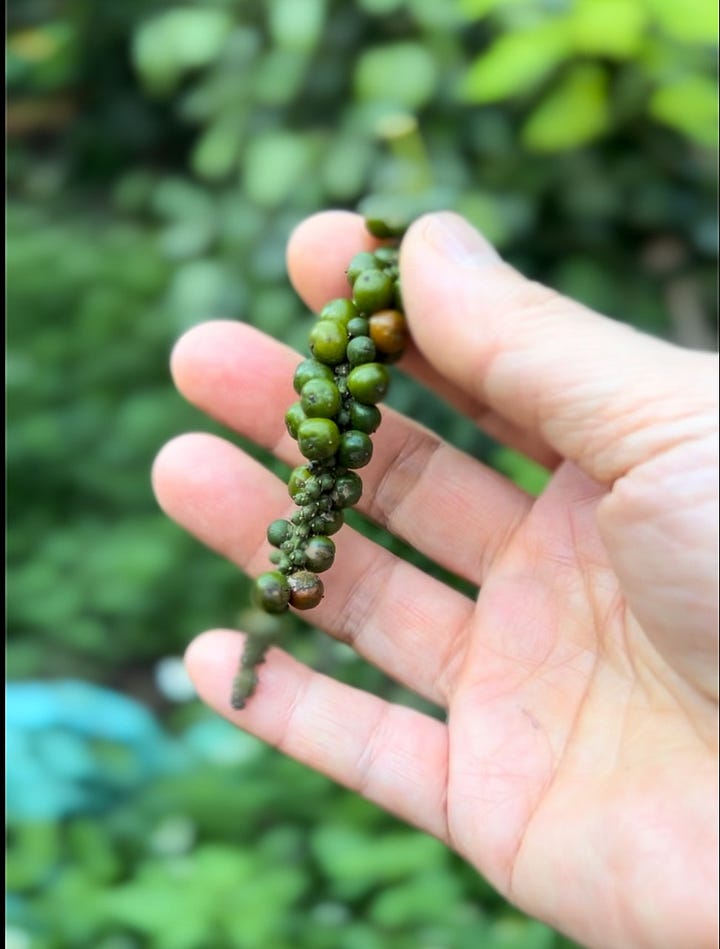
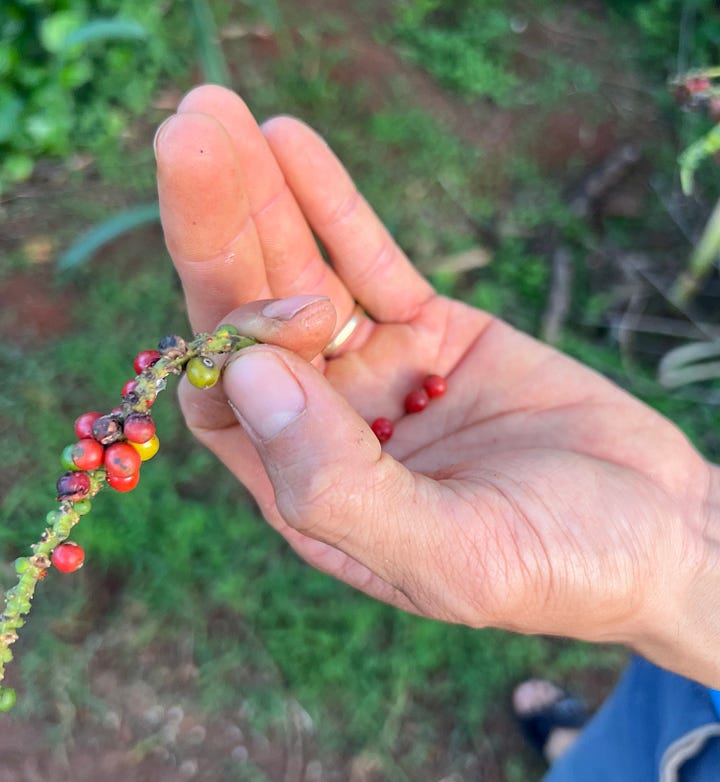
I’ve tried Vietnam-grown pepper sold by Whole Foods and Costco and their flavor isn’t as bright as what Dũng cultivates; his regular black pepper has a floral bite and his late-harvest purple peppercorns have superb sweet fire.
Dũng also experiments with growing other crops, such as star fruit, cacao, and durian. He cultivates honey bananas (chuối mật), an unusually sweet, thin-skinned banana that he dehydrates and hopes to export some day.
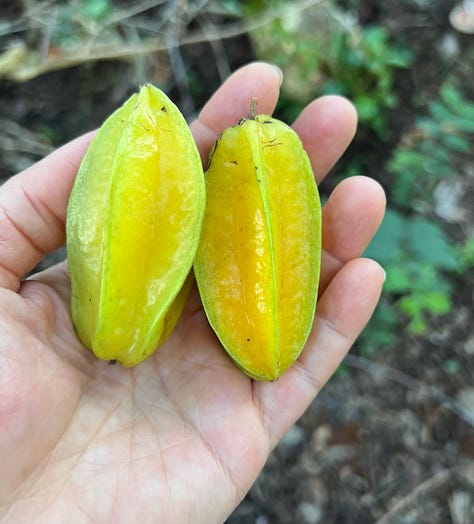
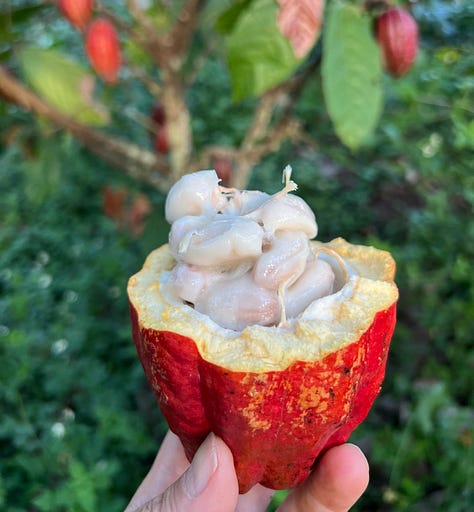

Why does Vietnam grow so much Robusta coffee?
After Brazil, Vietnam is the world’s second biggest coffee producer. About 80 percent is grown in the central highlands. Of the total coffee production in Vietnam, 95 percent is Robusta, according to Mercanta Coffee Hunters.
Robusta is often framed as low-quality coffee but is it really? And, as my friend Francis Lam, host of the Splendid Table podcast, loves to rhetorically ask: If there’s so much much Robusta around, where does it all go?
This video offers answers:
If Vietnamese business owners want to profit, why cultivate Robusta?
“Coffee requires cool and shade and Vietnam’s highlands offer that,” Dũng said. “Peppercorns provide shade under which coffee grows so they are good companion plants. The highlands’ volcanic soil is better for growing Robusta.”
Vietnam grows some Arabica and quality Robusta is on the horizon. In 2023 Starbucks headquarters in Seattle, I sampled very promising Robusta coffee from Vietnam. Unfortunately, they didn’t know when they’d have enough for the mass market.
And there I was, in Dũng’s spacious kitchen, looking at bags of Robusta beans ready to ship to Burlap and Barrel in Brooklyn. He had recently done a coffee cupping with Blue Bottle, a big player in the third wave coffee movement.
I wouldn’t leave Dũng’s house without tasting his coffee. He grows Robusta and Arabica and offered several blends. “Which beans would you like? How would like it brewed?” he said.
Hit me with 100 percent Robusta brewed with a pour over. (I’m not a Viet phin coffee filter purist.) He weighed the beans, hand ground them, then made us a cup.
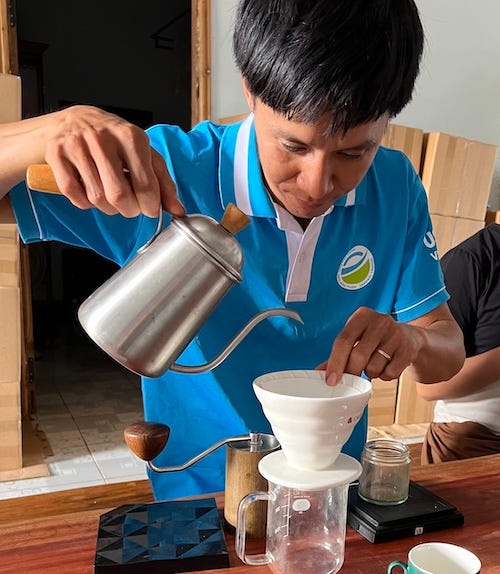

Dũng’s 100% Robusta coffee was roasted to a medium light state, which he prefers for showcasing the bean’s nuances. He admitted that most people like a darker roast. I enjoy a medium-dark roast but that aside, his coffee was smoother than other 100% Robusta that I’ve tried. It was devoid of the pencil lead flavor that I’ve encountered. I was impressed.
Are you coffee curious? I just found out that Dũng’s Robusta beans will sold by Burlap and Barrel. Keep an eye out for it!
In Vietnam’s large cities, craft coffee houses are in many hip areas, just like they are in America. Coffee culture in Vietnam is as strong as its beer culture so there’s an internal and external push for better coffee cultivation.
How to deal with politics in Vietnam?
Despite all the commerce that happens day and night in Vietnam, it is a communist country. In big cities there’s so much going on that you can easily ignore the Communist Party’s presence. However, in a small town like where Dũng and Hạnh live, the Party’s buildings occupy a fair portion of the main drag. Its banners, billboards and public announcements about loyalty to the country and Ho Chi Minh’s values seem ever present.
What is like for Dũng and Hạnh? How do they negotiate that? “We see them and understand them. We keep working hard,” Hạnh said.
Vietnam is a country where family and political contacts can determine your fate. Underdogs traditionally don’t have much of a chance to advance, but nowadays, because of international commerce and extra luck and pluck, people like Dũng have greater opportunities to get ahead.
Breakfast in Krong Nang
Before we said goodbye to Dũng, here’s how we spent the morning:
Banh mi pro tip » Eat fried egg banh mi while sitting or standing still to avoid drippy messes.
Thanks, Dũng, for sharing your community with me and Rory.






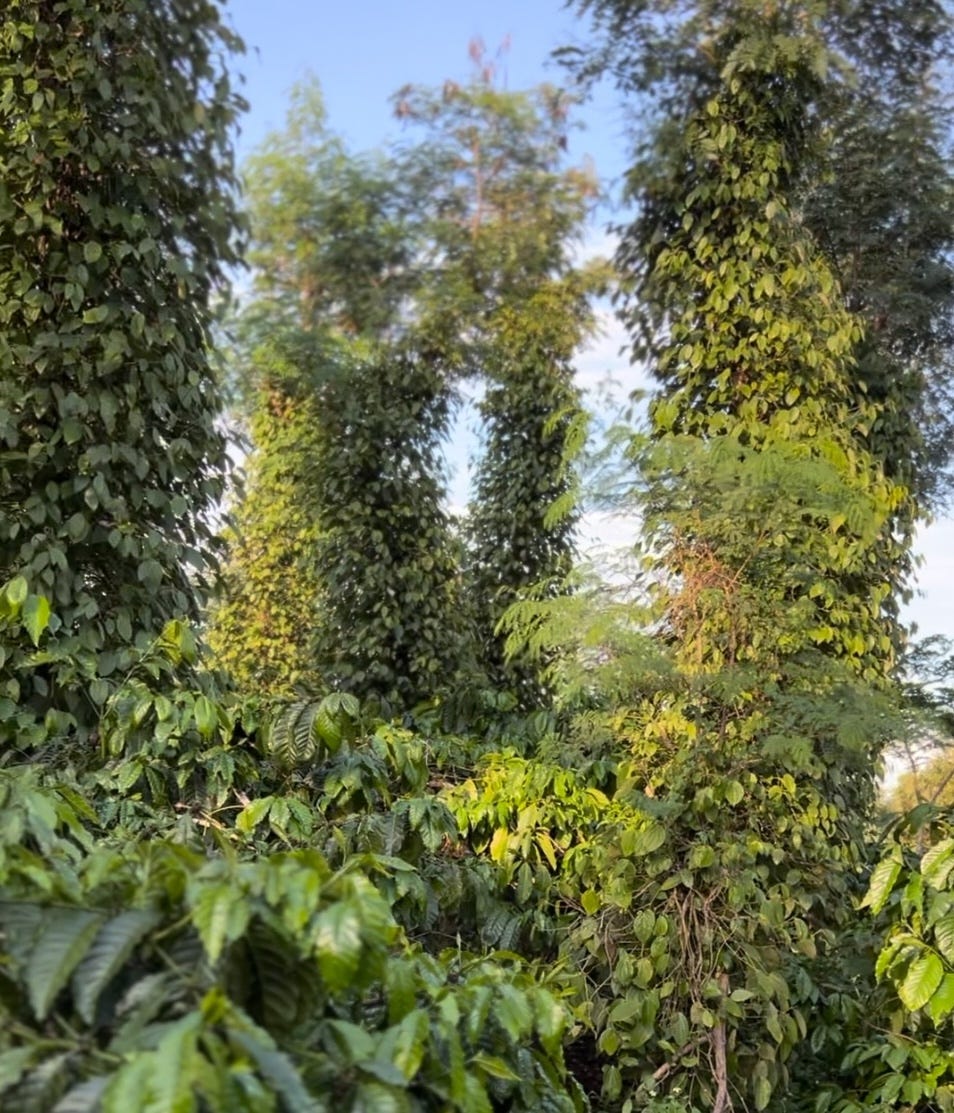


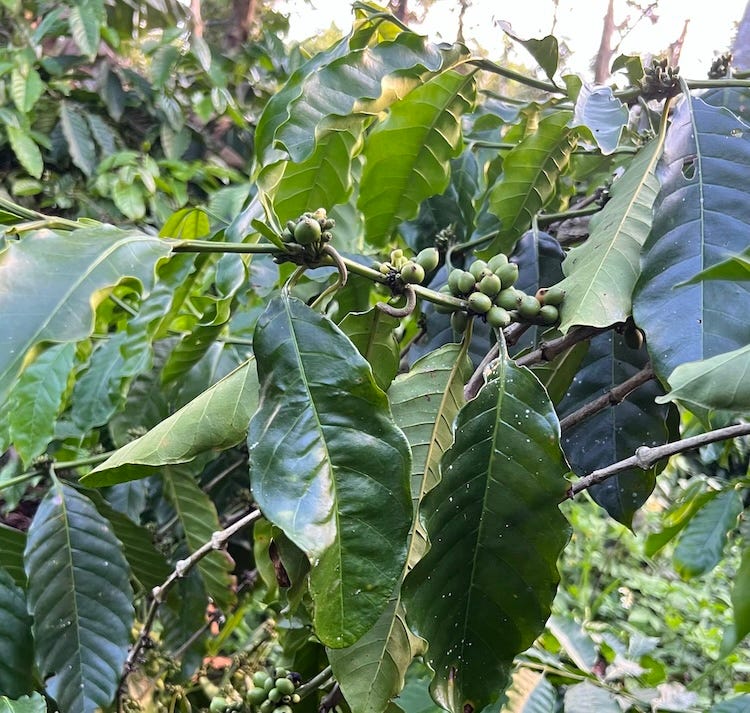

I loved reading this, Andrea. I will return to Viet Nam in 2025, for business, but we'll also spend time exploring as is our custom when we travel. I hope that we can include this area as a stop; although we won't be so bold as to overwhelm Dung and his wife.
I have fond memories from way back when my grandmother made coffee. They used a percolator, which was a common household appliance at the time. Drip coffee makers had yet to be invented and Keurig wasn't a word that anyone knew. I don't remember Starbucks or others being around. Maybe they were. In short, one made their own coffee. Theirs was delicious. They put salt, eggshells and what not into a grid from a can. I've never been able to replicate it and so wish I had asked them for their recipe. It seems to me that coffee making has become a bigger than life endeavor with custom roasters, grinding machines of all sorts, and secret sources!
How do you make coffee, Andrea? I'd share my process, but it doesn't produce anything I would drink!
Thanks for introducing us to Dung and his wife!
wow, what a great video glimpse of Vietnam and egg Banh Mi. Well done from the scooter!!